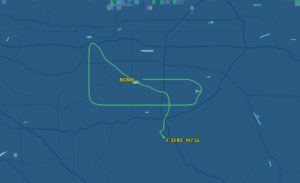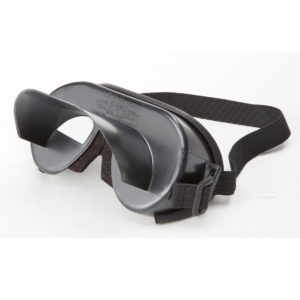Flying is fantastic! Everything looks different from the air, and in a small plane it looks different than when you are in the window seat of an airline. You are lower and slower than the big boys which gives you more time to look around and see things. If I was flying a high performance plane that could crank 90° banks or do barrel rolls that would be the highlight, but in the planes I fly the highlight is in looking out the window. Today there was nothing to see…
My check ride is getting closer. I’m trying to wrap up my ground school so that I can take my written exam in a couple weeks. The only requirements that I have left are 1.5 hours of simulated instrument time, learning recovery from unusual attitudes, and a couple more hours to go over the 40 minimum. (I think I will be between 45-50 hours when I take my check ride.) Other than that it is just dialing in the maneuvers.
Today the plan was to get in some simulated instrument time, learn recovery from unusual attitudes, and work on stalls. I told my CFI that don’t feel comfortable with stalls yet at all. He said that wasn’t unusual and that he thought he was comfortable with stalls until today when one of his students put the plane into a spin while working on stalls and he had to recover it for the student.
The only other time I did simulated instrument flight I didn’t have my own foggles so I had to use a set from the school that looked like this. You can’t see anything and have to turn your head just to see the radios.
I thought I was going to be smart and order a set of what my CFI calls “cheater foggles” which look like this. You still can’t see outside, although you can see light and dark areas. You can also see more of the panel which is nice.
With a plan in place for today’s flight we got the logbook from the receptionist.
CFI: “Do you have your own foggles?”
Me: “Yep, I bought some after the last time we did instrument flight.”
CFI: “Are they the good ones or the cheater ones?”
Me: “The cheater ones.”
CFI: (Walking over to the file cabinet and taking out the set from the school which someone actually put a sticker on the top that says ‘Da Hoodz’) “Then I’m going to have you use these.”
Me: “But, the cheater ones are legal.”
CFI: “I know, and you can use them on your check ride. But if you practice with these then your check ride will be a piece of cake with the cheater ones.”
Me: “Okay…” (I know he’s right, I’m just not excited about it.)
We went outside and I began the pre-flight on the plane. I started out in the cockpit, everything was good there. I put the flaps down and got out and started on the right wing. Flaps look good, aileron, wing tip, light, aileron counter weight, fuel to the tabs, fuel is blue (100LL), sump the tank and it’s good, but there are a few drops of hydraulic fluid on the ground under where the brake line connects to the caliper. The line has obviously had a little leak for some time given the amount of gunk on it, and I wouldn’t question it if it was just the line that was dirty but I knew the plane had just come back from a flight and hadn’t been sitting more than 30 minutes.
I called my CFI over to take a look and ask him if he’s concerned about it. He had the same thought that I did, the plane hadn’t been parked very long and with drips on the ground we decided to have the mechanic take a look. The owner of the school was there in the hanger too so they both came over to check it out. The owner grabbed a wrench, loosened the fitting and tightened it again to see if he could get it to re-seat. We opened up the cowl on the left side and checked to brake fluid level in the reservoir which was low. The owner went and got some fluid and a funnel and brought it up to the full level. My CFI put some fuel in the left tank to bring it up to the tabs and then we were sitting in the cockpit where I finished up the checklists and started up the plane.
I received taxi clearance, went to the run-up area, and worked through that checklist. Everything still looked good so I rolled out to the hold short line for 26R, the tower had me cross 26R to hold short at 26L and contact the tower on the other frequency. (It must have been a busy Saturday morning because they had the runways split on different frequencies, but by 3:30pm when we were out there everyone must have already found somewhere to go because there were only two other planes on the frequency.)
We lifted off and I kept the climb right on the numbers at 85mph and trimmed out the plane. We reached 1,100′ and I began my crosswind and then made a turn to the southeast toward the Lake Matthews practice area. As soon as I was making my turn he handed me the foggles with a “Here you go” and there went my view…
It is interesting how everything changes as soon as you can’t see outside. The amount of mental effort required to fly (for me at least) increases exponentially. He told me to fly a heading (I think it was 120°) and so I started an easy turn towards that heading. I was checking my altimeter (I was still climbing to 2,500′, my attitude indicator, airspeed, vertical speed indicator, turn coordinator, and heading indicator. Everything looked right, but the heading indicator did not seem to be changing even though the attitude and turn indicators showed me in an easy right bank. (That’s weird…) This went on for about 10-15 seconds until I realized that I wasn’t looking at my heading indicator, I was looking at the VOR Indicator. (Not a mistake I have ever made, but one that was obviously a result of the added mental stress of instrument flight.) I admitted the error to my CFI to which he responded “I was wondering” since I had turned well past the heading he was asking for.
I turned back to the requested heading and we proceeded to the practice area. Once there I turned to plane over to him and he told me to “look at my lap.” With my head down he proceed to turn, climb, descend, and then finally say “It’s your plane.” The engine was racing so I immediately pulled power while looking at the attitude indicator. We were in a right turning dive so I leveled the wings and pulled back on the yoke to bring it back to level flight. Once the speed bled off I pushed the throttle back in to bring it back to 2,200 rpm, gave the controls back to my CFI and looked back down at my lap. This time he tried harder to confuse me and even got my head to spin a little before saying “It’s your plane.” Right before giving the controls back to me I heard the RPM’s drop. A quick glance at the attitude indicator showed we were in a climbing left bank and the airspeed indicator showed the airspeed rapidly decreasing. I added full throttle and simultaneously turned the yoke to the right and pushed forward to level the plane. Once the airspeed was coming back up I decreased the throttle and had us straight and level.
When talking about the procedure to recover from unusual attitudes before flying I had told my CFI that in my mind I didn’t think it was going to be very difficult. He said that it really isn’t and that it would probably be even easier than I thought. He was right, it wasn’t hard. I actually seem to struggle more with straight/level flight by instruments than recovering from unusual attitudes.
We did one more unusual attitude recovery and then he told me to fly direct to the Paradise VOR. On the way he planned out a route to fly and had me make notes. Taking notes while flying by instruments, trying to track a radial and maintaining a steady climb to altitude was an interesting/challenging experience to say the least. He changed our original plan (which was to split the 1.5 hours of simulated IFR into two flights) and instead decided to have me fly a triangle route from the Paradise VOR, to the Pamona VOR, then south to intersect a radial from Paradise before tracking that in.
I realized as I was flying extended time in simulated IFR that when I am flying VFR I don’t look at my attitude indicator much at all and only glance down at my turn indicator to make sure I am staying coordinated. For straight and level flight, turns, climbs, and descents I rely almost completely on the horizon outside the plane. I don’t have any problem making a turn and rolling out right on a specific heading, when I can see outside. However, under the hood that all changes. I would roll out early, roll out late, drift into a shallow turn and notice my heading had changed 5-10°, I was all over the place. Chasing the radials turned out to be quite the task.
About the time we reached the Pamona VOR and turned south I finally had it and was able to fly a straight heading and stay on the radial. When the radial from Paradise started to come in I made a gradual turn, lined up on it, and tracked it in.


My CFI was doing all the radio work, flying by instruments and talking on the radio is past my current capabilities. In fact, unlike our other flights there was very little conversation between us, I was too busy trying to concentrate on those darn instruments. At one point I told him “This must be so boring for you.”
As we were approaching the Paradise VOR my CFI asked approach for vectors to the Chino ILS. I followed the headings from SOCAL Approach and soon we were on the ILS and I was chasing the localizer and glideslope.
CFI: “Watch the localizer, if you’re going to miss it miss to the right. If you drift left you could end up on approach for 26L.” (The ILS at Chino is on 26R.)
ME: “Okay”
CFI: “Watch the glideslope.”
Me: “Okay”
Elevation at KCNO is 650′ and the minimum for the ILS is 886′. I got down just under 900′ and for the first time since I turned toward the practice area an hour before and about 85 miles of flight, I looked outside the plane. We were flying towards the sun and my first reaction was ‘It’s bright out there!’ It was so strange to have been flying for so long without having seen anything.
I was pleased to see that I was almost lined up on the runway. The problem was that I had drifted below glideslope. My CFI said,”See how close those trees are?” (As we were passing over them.) “This is what four reds on the PAPI looks like. That’s why you never want to be below glideslope. If you’re going to miss the glideslope, miss high.” The truth is that I had not even noticed that I had drifted below the glideslope. I had been right on it until maybe the last 10 seconds when I had taken my eye off the glideslope and instead was watching the altimeter to see when I could finally take the foggles off. That was enough time to sink low…
I added power to stop my descent until I was back where I should be and then settled down for a nice soft landing with just one notch of flaps (10°) in. I missed the centerline to the right but got a “Very nice” from my CFI as the plane settled down on the runway.
I’m down to just 0.5 of simulated IFR needed. Next Saturday I fly again with my CFI and we’ll go through all the required maneuvers to see what I need to work on. In the mean time I will try and get my ground school completed and schedule my written exam.
It really is getting close…



